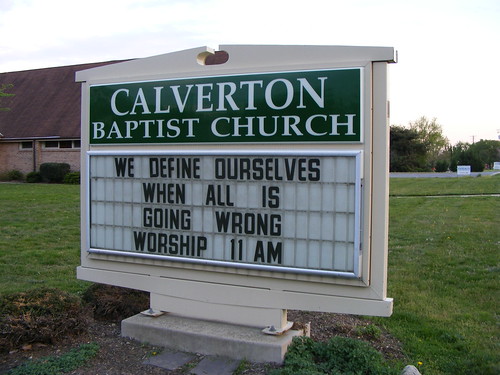 I don't go to Calverton Baptist Church (I mean, I don't really go to any church, but I could walk here from my house if I felt like it) but I thought their sign was especially prescient this week. These are rough times for our country and for our community, but in the struggle lies an opportunity. On the Kojo Nnamdi show last week, professor/columnist/urban planner/my hero Roger K. Lewis mentioned that the economic downturn presents us with a time to "catch up" with growth, if you will. Not just in terms of infrastructure like roads, transit and schools, but with developing a vision for our future.
I don't go to Calverton Baptist Church (I mean, I don't really go to any church, but I could walk here from my house if I felt like it) but I thought their sign was especially prescient this week. These are rough times for our country and for our community, but in the struggle lies an opportunity. On the Kojo Nnamdi show last week, professor/columnist/urban planner/my hero Roger K. Lewis mentioned that the economic downturn presents us with a time to "catch up" with growth, if you will. Not just in terms of infrastructure like roads, transit and schools, but with developing a vision for our future."We define ourselves when all is going wrong," reads the sign. This is a time to look at the East County we know and position ourselves for a time when, hopefully, we have the means to start growing again. It's worth noting that our local master plans - White Oak, Cloverly and Fairland - will be up for revision in a few years. When the economy picks up, will we pick up where we left off and continue building car-oriented subdivisions and strip malls, fearful of density, traffic and "undesirables," or will we try to tackle these concerns proactively rather than running away from them?

1 comment:
Well, Dan, I don't know that we'll be needing to grow all that much...
Look, we don't know where this Swine Flu thing is headed, but you might recall my Challenge to DC Area Urban Planning Bloggers -- Part I:
[ ... ]
Yet there is another situation in which urbanized areas are the most dangerous place to be, and that situation has been seen here in the US within the last century. A hint in the form of a question: in which decade of the Twentieth Century did Census record an actual decline -- the only recorded decline of the US Census enumeration record -- in population, and why?
And here comes our Challenge:
In the fall of 2012, a global Pandemic struck the world. It was fast, it was universal, it was global; everyone got it with absolutely no exceptions except for a few paranoids hiding in deep facilities, and when they finally emerged, they got it too. The fatality rate was about 50 percent under the best of conditions and with the best of care; without the best care in the best facilities the Pandemic left about one in 7 people alive. Those who died all died within about 72 hours of developing symptoms; those who lived were almost fully recovered -- and were thereafter totally immune -- within one week of onset of symptoms.
[ ... ]
It's pretty unlikely that we're all dooooomed and will see significant population reductions here. Still, as long as we keep urbanizing and overpopulating, we keep increasing the risks of pandemic as well as increasing our impacts on the planet.
So, keep that in your considerations as you ponder... that there are limits to growth, and we may have significantly overshot them already.
Post a Comment